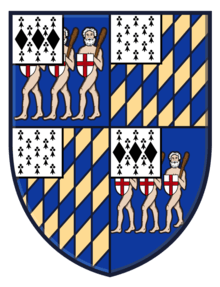Earl of Halifax
Earl of Halifax is a title that has been created four times in British history, once in the Peerage of England, twice in the Peerage of Great Britain and once in the Peerage of the United Kingdom. The name of the peerage refers to Halifax, West Yorkshire.
1679 creation

1st Earl of Halifax
The first creation, in the Peerage of England in 1677, was for William Savile, 1st Viscount Halifax. He had already been made Baron Savile of Eland and Viscount Halifax in 1668 and was later made Marquess of Halifax (this creation of the earldom became extinct in 1700; see Marquess of Halifax for more information).
1714 creation
The title was recreated in the Peerage of Great Britain in 1714 for Charles Montagu, 1st Baron Halifax, First Lord of the Treasury to George I, along with the courtesy title of Viscount Sunbury. Both titles were created with remainder to heirs male. A member of the prominent Montagu family, he was the son of George Montagu, younger son of Henry Montagu, 1st Earl of Manchester (see the Duke of Manchester). Montagu had already been created Baron Halifax, of Halifax in the County of York, in 1700, with remainder, failing heirs male of his own, to his nephew George, son and heir of his brother Edward Montagu.
1715 creation
On Lord Halifax's death in 1715 the viscountcy and earldom became extinct. He was succeeded in the barony according to the special remainder by his nephew George Montagu. Less than a month after his uncle's death, both titles were revived in his favour, making him Earl of Halifax and Viscount Sunbury. He was succeeded by his son, the second Earl, who was a prominent statesman. However, on his death in 1771 all the titles became extinct.
1944 creation
.jpg)
1st Viscount Halifax
The title was created for a fourth time in the Peerage of the United Kingdom in 1944 for Edward Wood, 3rd Viscount Halifax, the former Foreign Secretary and Viceroy of India. The Wood family descends from Francis Wood, of Barnsley. His second son, Francis Wood, was created a Baronet, of Barnsley in the County of York, in 1784, with remainder to his elder brother the Reverend Henry Wood, and failing him to the sons of his younger brother Charles Wood. He was succeeded according to the special remainder by his nephew, the second Baronet (the son of Charles Wood).
His son, the third Baronet, was a prominent Liberal politician and served as Chancellor of the Exchequer from 1846 to 1852. In 1866 he was created Viscount Halifax, of Monk Bretton in the West Riding of the County of York, in the Peerage of the United Kingdom. His aforementioned grandson, the third Viscount, was also a noted politician. In 1925, nine years before he succeeded his father, he was himself raised to the Peerage of the United Kingdom as Baron Irwin, of Kirby Underdale in the County of York. In 1944 he was further honoured when he was made Earl of Halifax. As of 2009 the titles are held by his grandson, the third Earl, who succeeded his father in 1980.
Another member of the Wood family was the Conservative politician Richard Wood, Baron Holderness. He was the second son of the first Earl of Halifax.
The family seat is Garrowby Hall, near Garrowby in the East Riding of Yorkshire
Earl of Halifax; first creation (1679)
Barons Halifax (1701)
- Charles Montagu, 1st Baron Halifax (1661–1715) (created Baron Halifax in 1701 and Earl of Halifax in 1714)
Earls of Halifax; second creation (1714)
- Charles Montagu, 1st Earl of Halifax (1661–1715)
Barons Halifax (1701; reverted)
- George Montagu, 2nd Baron Halifax (1685–1739) (created Earl of Halifax in 1715)
Earls of Halifax; third creation (1715)
- George Montagu, 1st Earl of Halifax (1685–1739)
- George Montagu-Dunk, 2nd Earl of Halifax (1716–1771)
Wood Baronets, of Barnsley (1784)
- Sir Francis Wood, 1st Baronet (1728–1795)
- Sir Francis Lindley Wood, 2nd Baronet (1771–1846)
- Sir Charles Wood, 3rd Baronet (1800–1885) (created Viscount Halifax in 1866)
Viscounts Halifax; second creation (1866)

- Charles Wood, 1st Viscount Halifax (1800–1885)
- Charles Lindley Wood, 2nd Viscount Halifax (1839–1934)
- Edward Frederick Lindley Wood, 3rd Viscount Halifax (1881–1959) (created Earl of Halifax in 1944)
Earls of Halifax; fourth creation (1944)
- Edward Frederick Lindley Wood, 1st Earl of Halifax (1881–1959)
- Charles Ingram Courtenay Wood, 2nd Earl of Halifax (1912–1980)
- Charles Edward Peter Neil Wood, 3rd Earl of Halifax (b. 1944)
The heir apparent is the present Earl's only son, the Hon. James Charles Wood, Lord Irwin (b. 1977)
The heir apparent's heir is his only son, the Hon. Rex Patrick Wood (b. 2010)